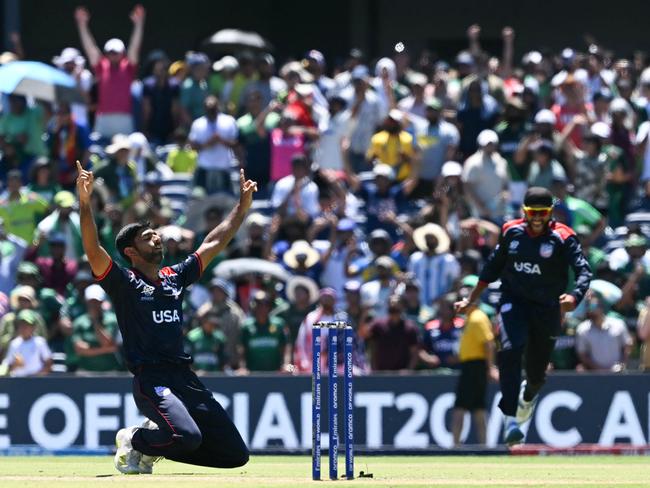T20 World Cup Analysis: The ICC’s calculated risk behind cricket’s great American bash
The USA’s shock win over Pakistan may justify cricket’s American expedition with cricket fans, yet as SHANNON GILL discovers with ICC bean counters, the business of cricket could no longer afford to ignore North America.

The smiles from the United States cricket team that shocked Pakistan this week may only be matched by those at the ICC.
It’s been billed ‘the greatest upset in cricket history’ but it might also help silence cynics about any gimmickry in staging the ICC T20 World Cup in the USA.
The promotional blitz has been ferocious – see Usain Bolt opening the New York Stadium, Yuvraj Singh appearing on Good Morning America and Rohit Sharma posing with the NBA’s Larry O’Brien trophy – yet the ICC’s Chief Commercial Officer Anurag Dahiya is not indulging in marketing speak with evangelical fervour.
In his mind, cricket simply couldn’t afford to ignore America any longer.
Cricket Lovely Cricket ðŸ
— Usain St. Leo Bolt (@usainbolt) May 15, 2024
The Nassau County International Cricket Stadium was launched by the Men's #T20WorldCup 2024 👊🿠pic.twitter.com/MeasToW5sF
United States of Revenue
“When we did our last media rights deals, the US was in the top three TV markets,” Dahiya tells CODE Sports.
“You don’t see the US as a cricketing country but that’s the size of the market with limited penetration.”
The USA trails only India and the UK as far as commercial value derived from ICC broadcasting. Dahiya says that is the tip of the iceberg.
“We feel that in time it will be second only to India.”
Then consider that the conservative end of ICC research suggests the potential cricket following population in the US is greater than Australia’s total population.
“There are 30 million latent cricket fans in the US which makes it a pretty massive market.”
Texas, and specifically Dallas, is home to a major South Asian subcontinent cricket following community. Likewise the east coast tri state area of New York, New Jersey and Connecticut.
The Silicon Valley area from northern California all the way up to Seattle has exploding numbers of South Asians working in the tech industry, while Florida with its Caribbean community makes it a cricket-literate area.
In a commercial sense that demography is valuable too.
“That South Asian diaspora are well educated, high income earners and very attractive for marketers.”
The latest measurements of cricket’s digital footprint in the USA has those fan figures heading towards 50 million.
“I think in years to come that 30 million figure will look very conservative,” Dahiya says.
Those numbers, combined with the US’s thirst for sport, makes for a tantalising equation. The ICC says that at approximately 25 billion dollars per year the US sports rights market is 6-7 times bigger than the next biggest market (the UK) in the world.
“In pure product management terms you say ‘hang on, why are we not in that market.”

The long US conversation
This American awakening is not a recent revelation for the ICC.
The numbers have been trending in this direction for the last two decades, the notion of testing that with something big has been around almost as long.
“It’s been a very long conversation,” confirms Dahiya.
Lack of facilities was compounded by ongoing instability with the US governing body for cricket.
The USA Cricket Association was suspended by the ICC in 2015 and then expelled in 2017 due to governance issues.
“It had been a fragile governance structure and it never quite gave anyone confidence to give an event to the US,” Dahiya says.
“It’s been taken off and then been put back on the backburner a number of times. It remained a theoretical discussion for a number of years.”
Ultimately the USACA was dissolved, and a new body, USA Cricket, rose from the ashes with ICC support to be readmitted in 2019.
When decisions were made for this World Cup in 2021, the ICC was finally convinced in taking a calculated risk.
Playing in temporary venues requires investment that the ICC will take a financial hit on compared to other World Cups. Progress also requires some tolerance; the first week of the tournament has been rife with discussion about the quality of the pitch installed in New York.

Yet for Dahiya it’s an investment that will pay off in various ways for the ICC and its member countries.
“Broadcast rights will grow, not just for the ICC but for all our country members,” he says.
If he’s right, Cricket Australia and other nations will see a bigger cheque from the US when it takes its media rights to market there next, in turn investing that in the game at home.
Dahiya believes American exposure will also result in increased sponsorship returns due to the concentration of corporate decision making that happens in North America.
“Better presented cricket in the US will eventually be reflected in better support from multinational brands,” Dahiya says, citing the ICC’s recent renewal of its deal with Coca-Cola.
“Earlier this deal was driven by the South Asian market, the nuance of this deal is that it’s now a global deal managed out of Atlanta, like FIFA or the Olympics.”
American attraction
While the revenue figures sound great based on reaching that latent audience, the more intriguing thing for cricket lovers is whether Americans with no cricket knowledge could convert.
Amid some baseball versus cricket banter on X this week, ESPN NFL journalist Ben Baby posted: “It’s a shame the T20 World Cup, which is hosted by the US, isn’t being broadcast in the US. Would be fun and easy to see so many folks try a new sport.”
That is a little misleading.
Willow TV, a 24/7 cricket streaming and cable channel in the US, will cover the tournament in its entirety, as it does for most major cricket in the country.
Granted, Willow TV caters to the existing fanbase, but as Dahiya points out the first week of the tournament is being made free to anyone in the US. One of the objectives of the tournament is to get the more ‘mainstream’ broadcasters like ESPN interested next time rights go to market.
At stadiums in the US this week Dahiya has been buoyed by scenes of fans dragging along uninitiated friends to the game.
“In Dallas, there were groups of people all over the stadium, typically with one South Asian guy in the middle explaining the game. That’s what we were hoping for.”

There’s also been pop culture incursions.
“The New York Post and New York Times have featured it prominently and we’ve had crossovers with other sports,” Dahiya says.
“Suddenly people wake up to the fact that Virat Kohli has more social media followers than the top three NBA players combined. People are saying ‘wow, who is this guy and what is this sport.’”
The NBA posted its side-by-side trophy tour with the ICC on social media and put in a puzzled call to the ICC afterwards.
“They said ‘we’re getting a lot of hits on this, is this usual for you guys?,” Dahiya says.
Of course, winning helps too.
Mainstream US media covered the shock triumph over Pakistan, ESPN’s flagship SportsCenter program featuring it as a headliner while amusingly adapting terminology for its audience.
“In one of the greatest upsets of all time, the Americans won in overtime,” said the announcer.
Like it did in Melbourne in 2022, the sheer fervour of the sellout India and Pakistan clash in New York is expected to make an impact too.

Drive to one million
Bank balances and sound bites are nice, yet the greatest legacy this World Cup can leave is people picking up a cricket bat.
The four-year window from now until the 2028 Olympic Games in Los Angeles shapes as the most crucial period ever for the game in the USA. The ICC is supporting the fledgling US Major League Cricket T20 competition that will follow the World Cup.
Once seen as a novelty, the league will feature nineteen Australians, headlined by Test skipper Pat Cummins and including seven of the World Cup squad.
Modified versions of the game have been introduced to schools in America alongside all this activity, with a focus on the aforementioned hotspots. The targets are ambitious.
“The plan is to get a million kids playing cricket in the US by the next Olympics,” Dahiya says.
“We’re book ending it with these two events; we kick off things with the World Cup and see where we can take it by LA ‘28.”
These sorts of statements are often made by sporting organisations with little accountability in the aftermath, yet credit has to be given to the ICC. Once derided for contracting the game in the name of a dollar, not many sports would take a money-spinning event to virgin territory in chase of an expansionary goal.
“These kinds of growth numbers can only come through when you’re willing to invest in the market,” Dahiya says.
“We don’t pack up and leave. The sport is here to stay.”





